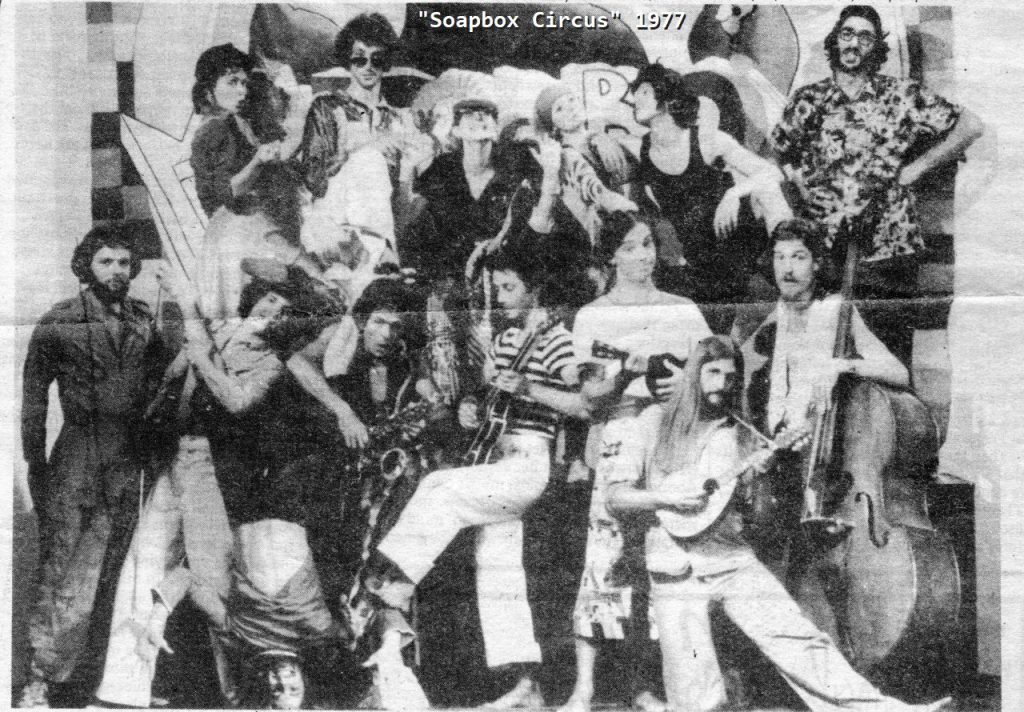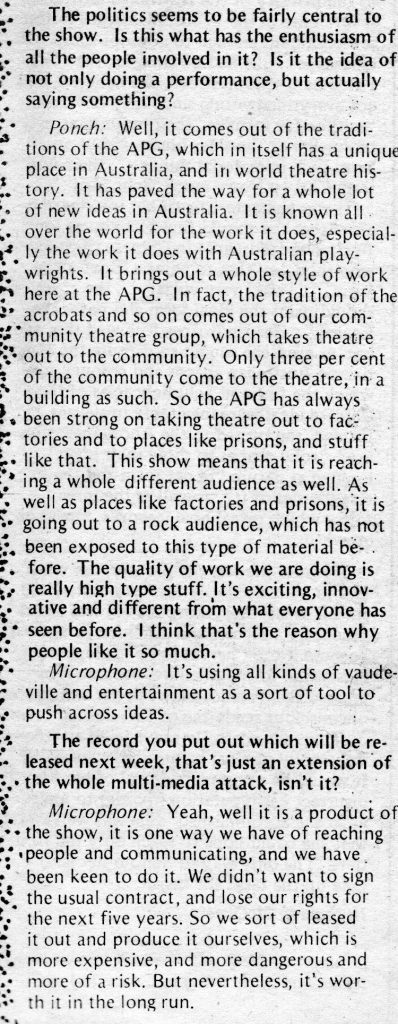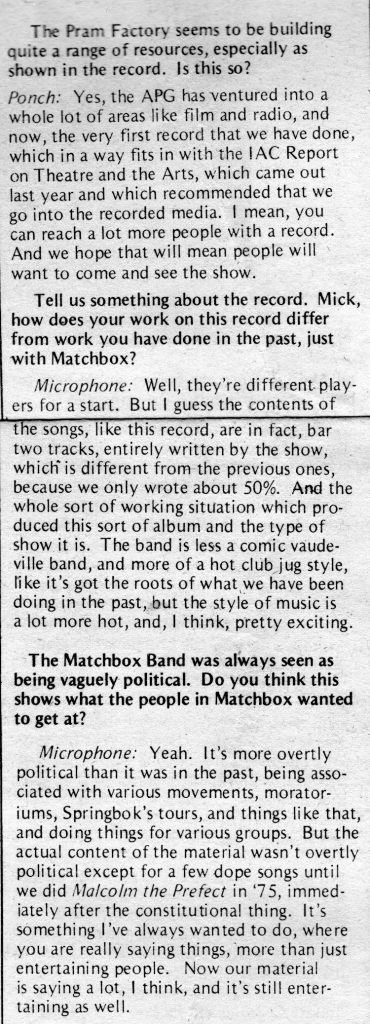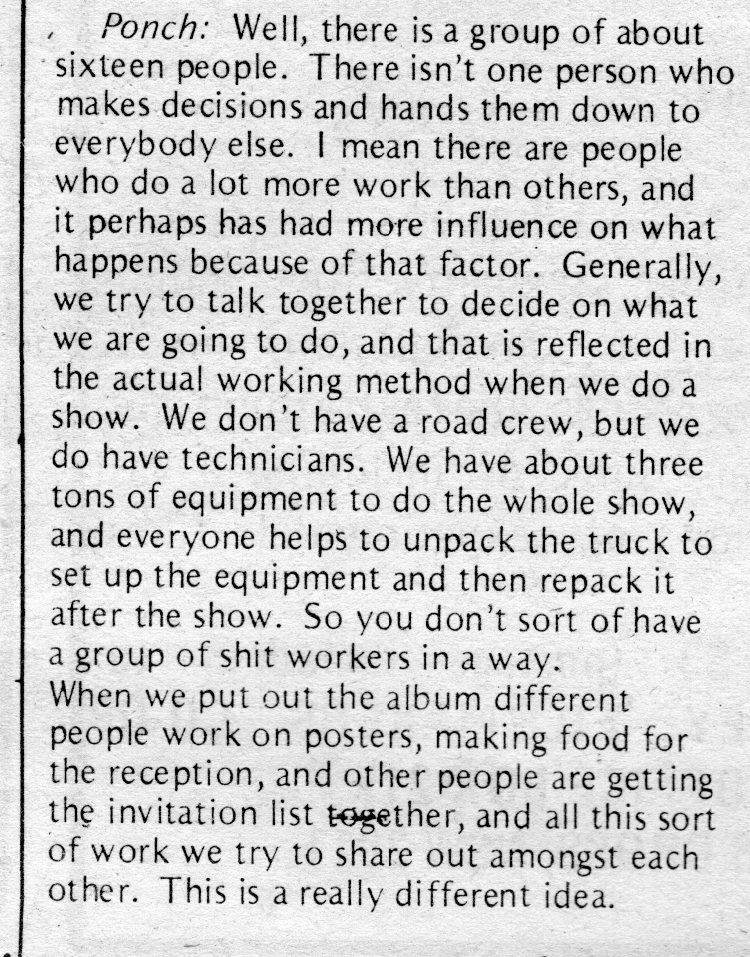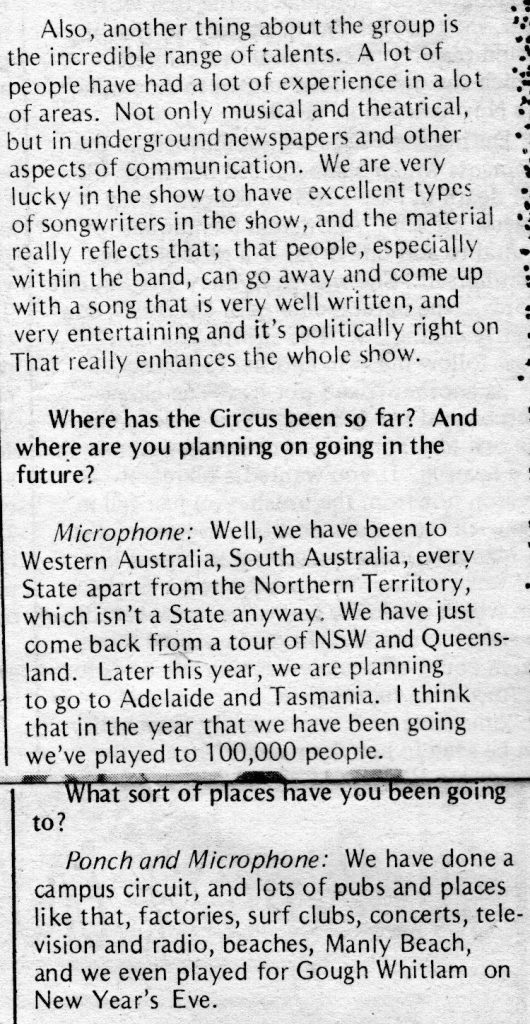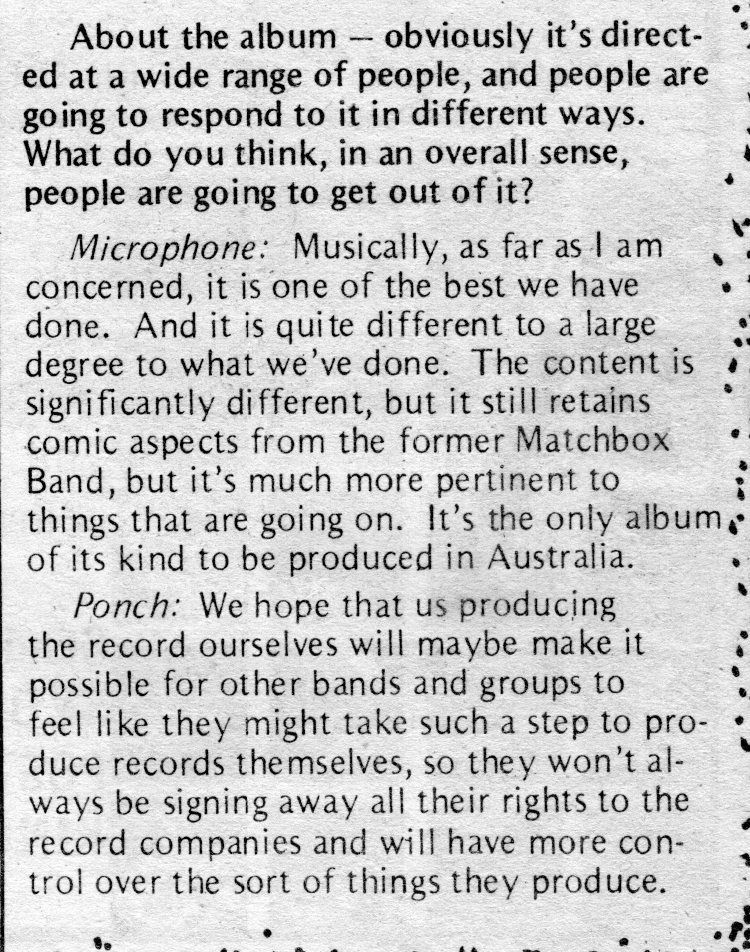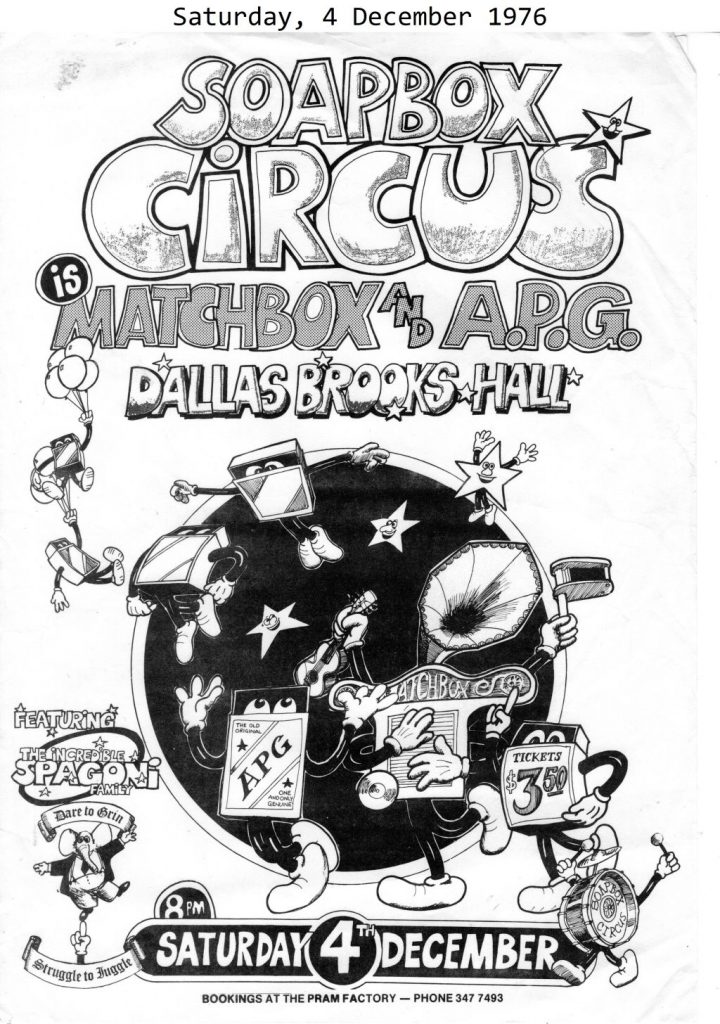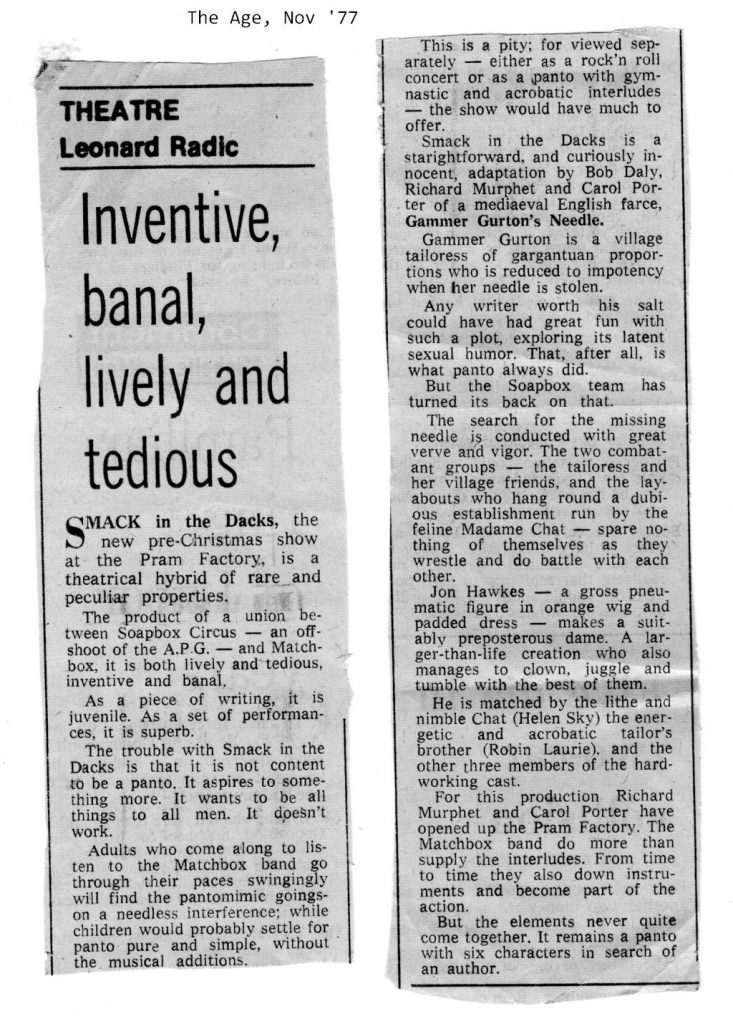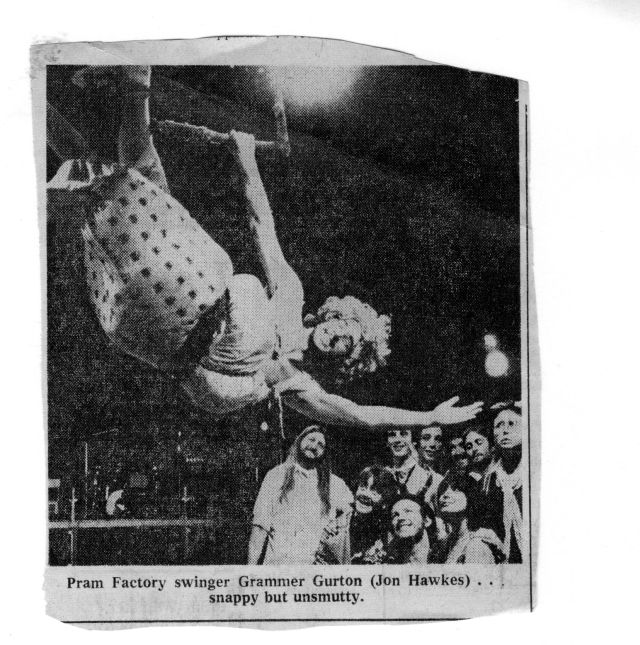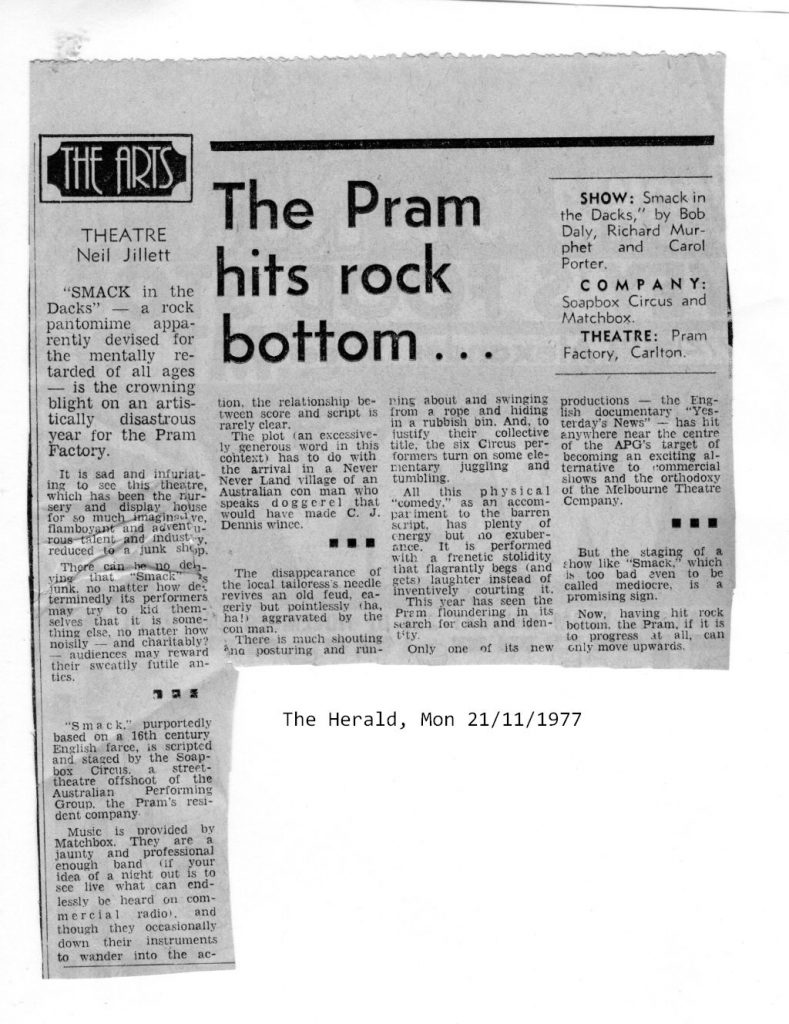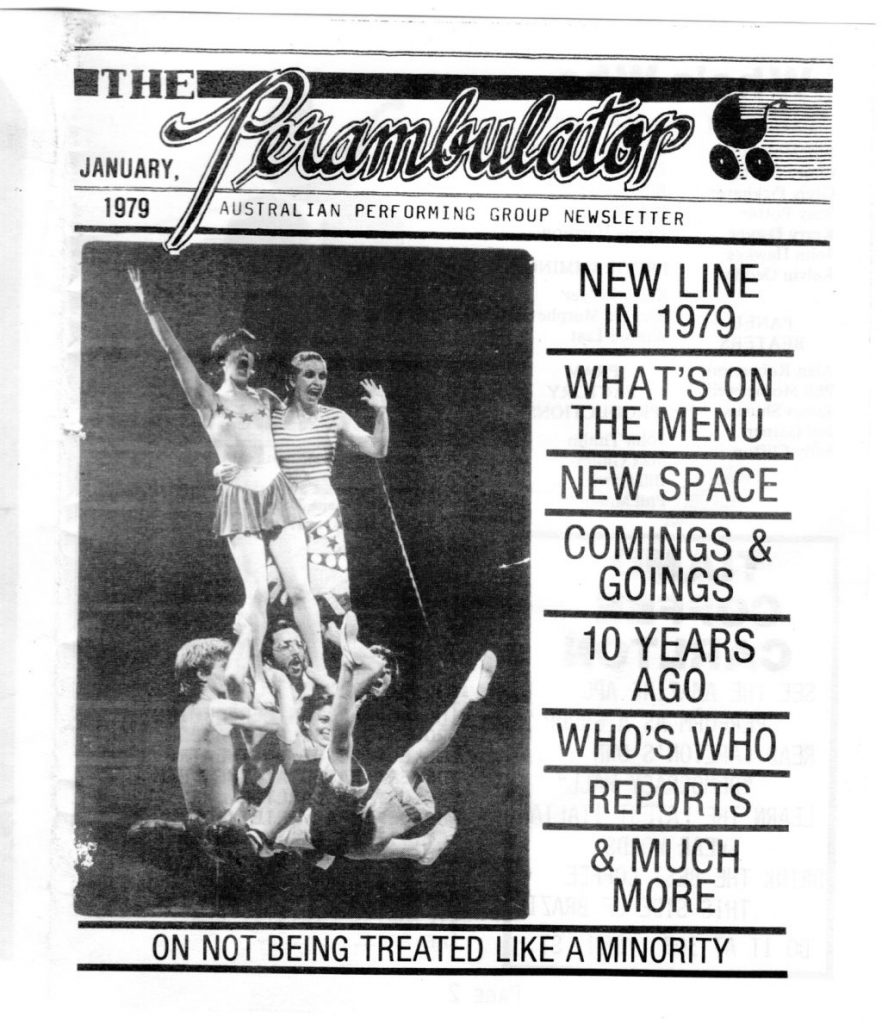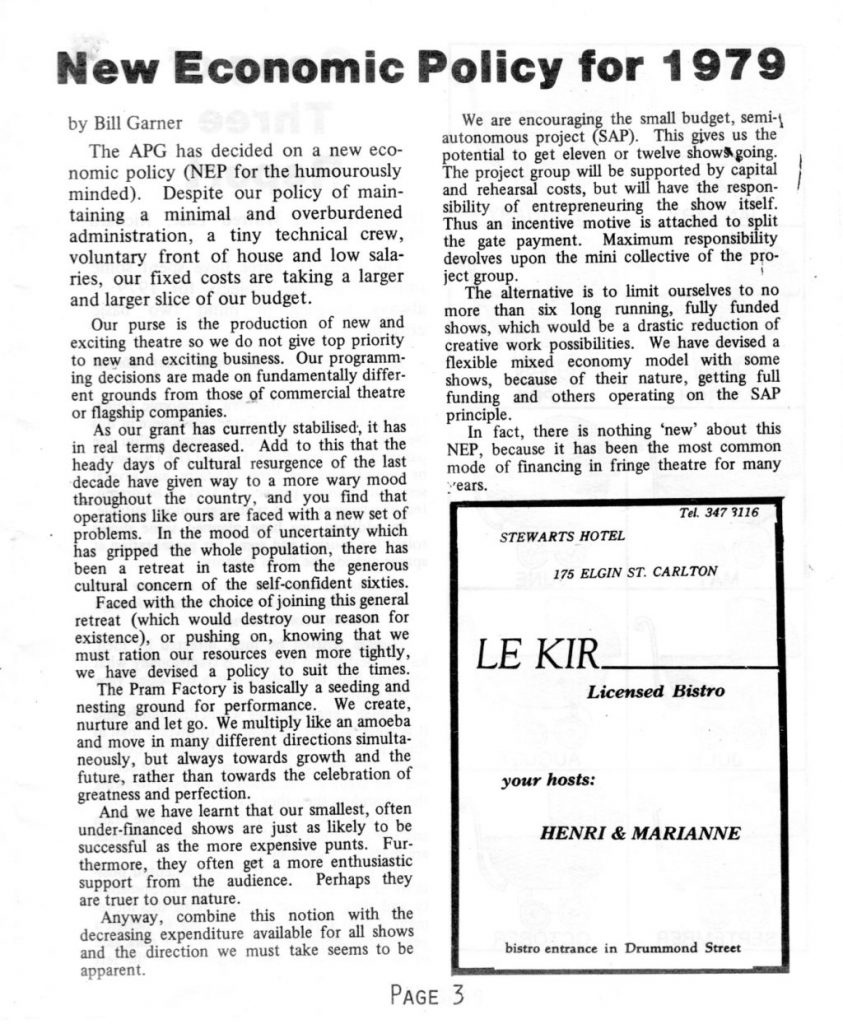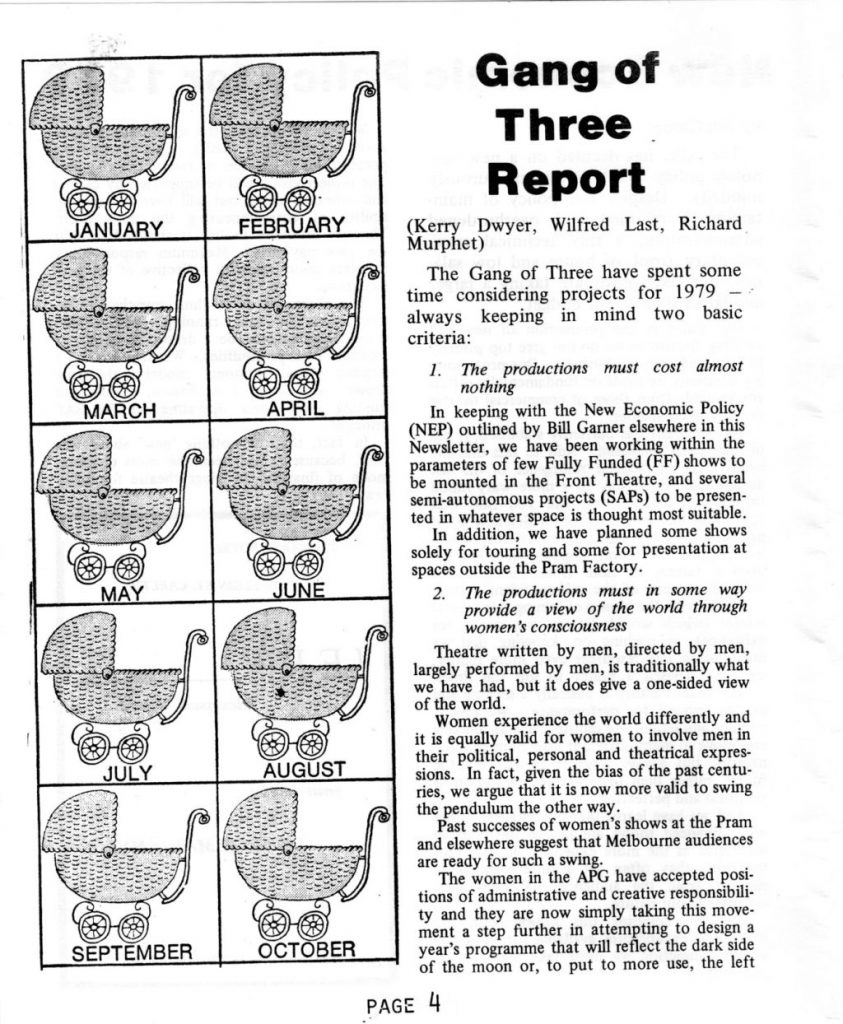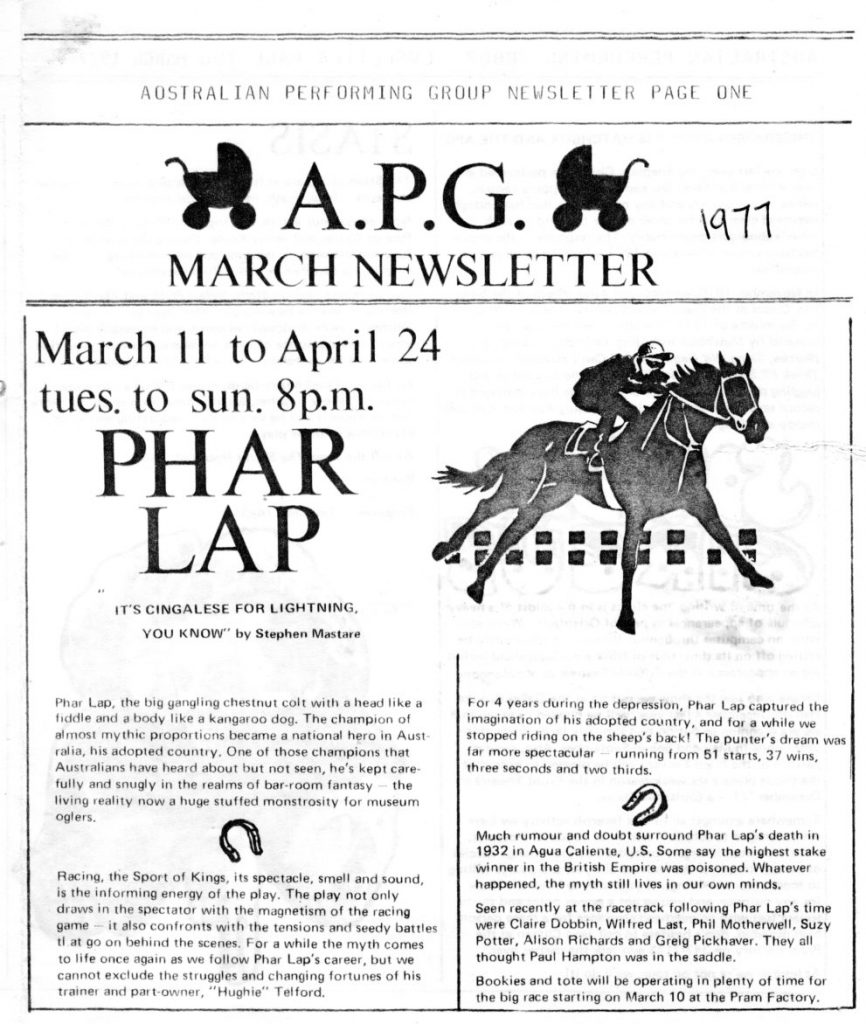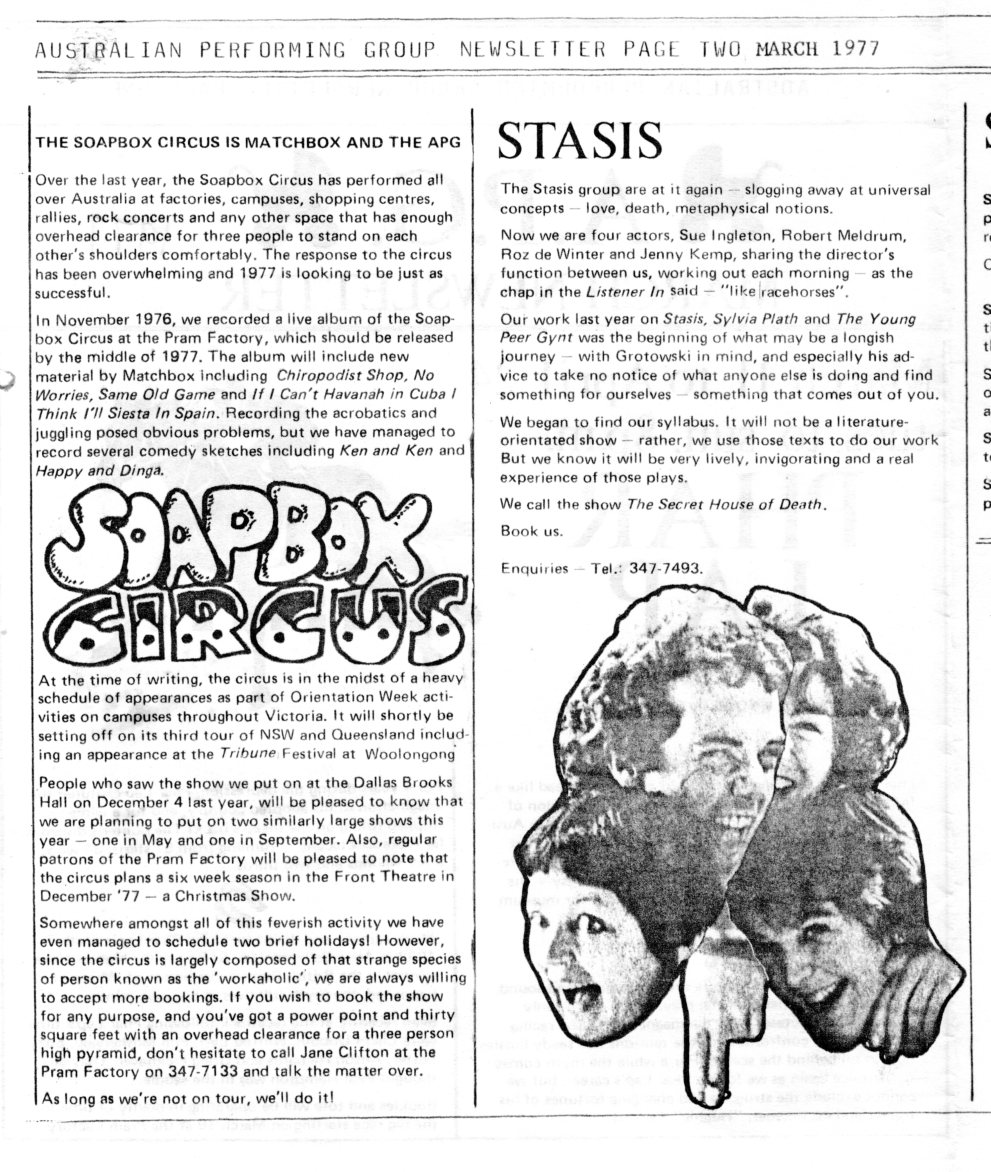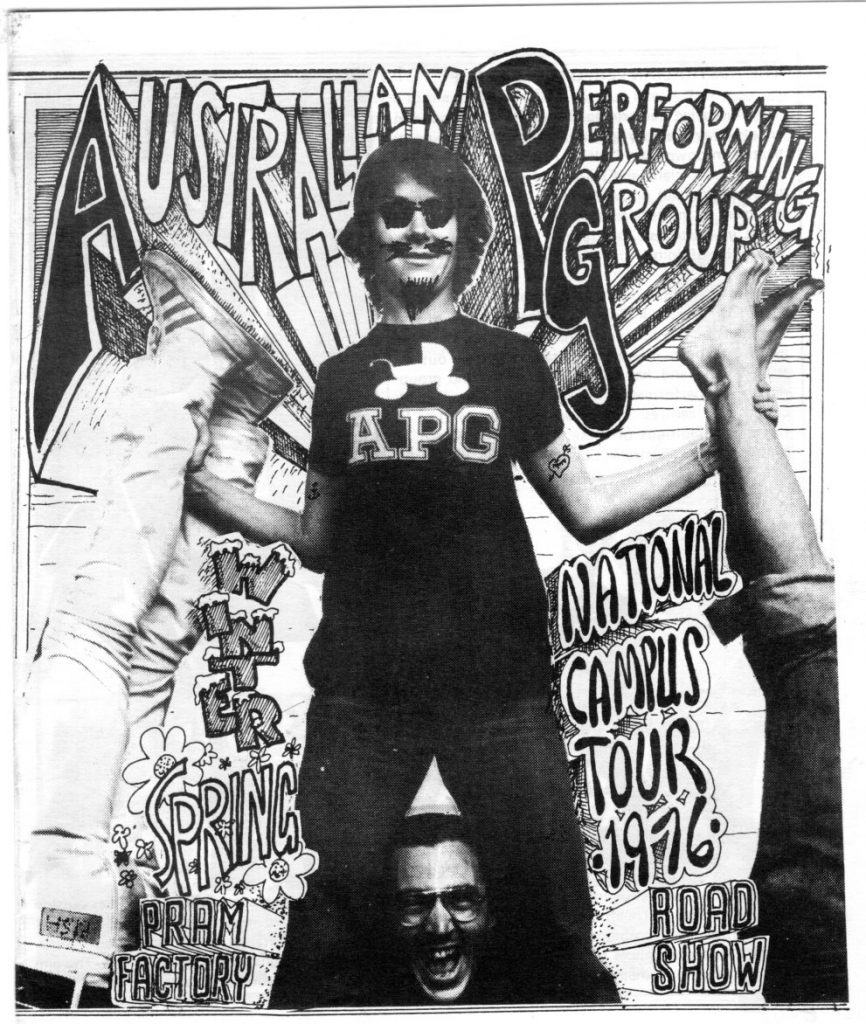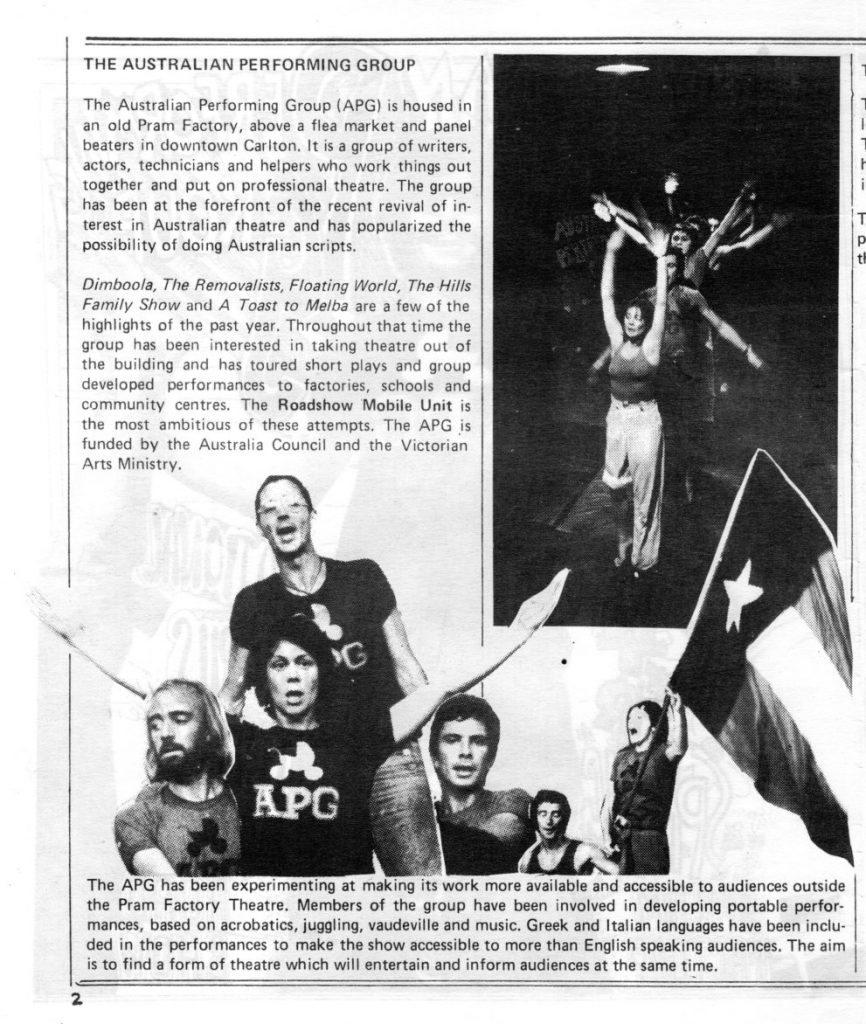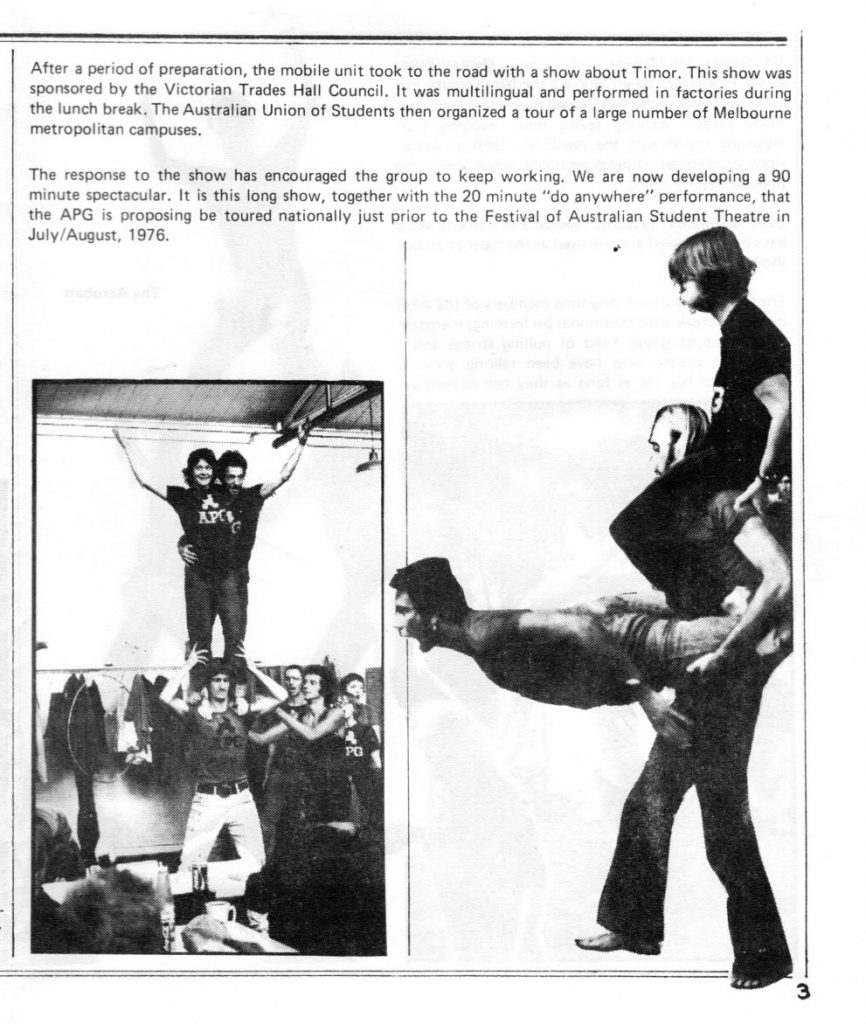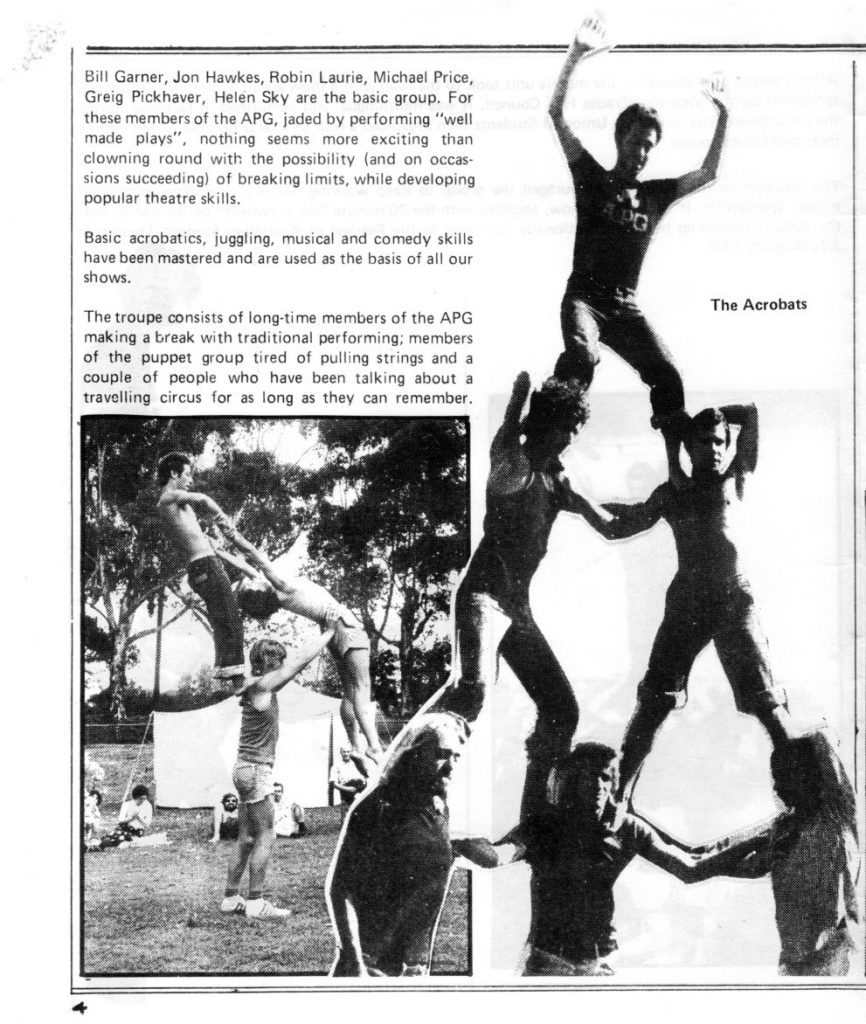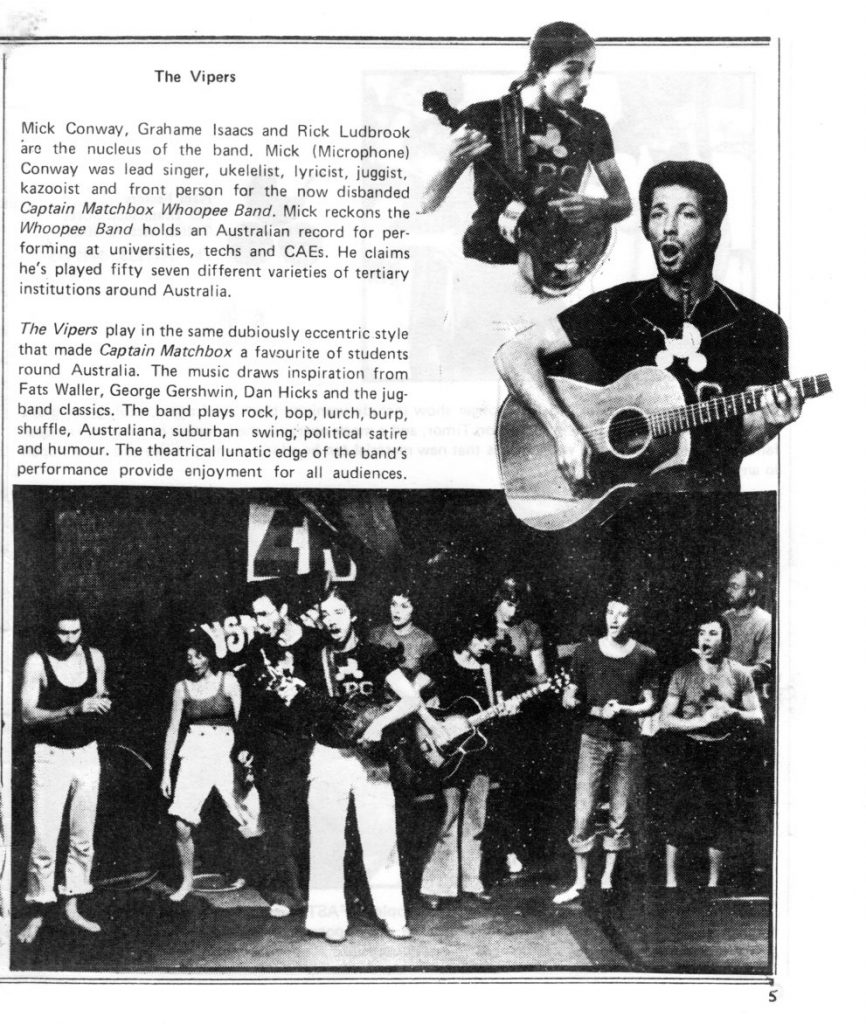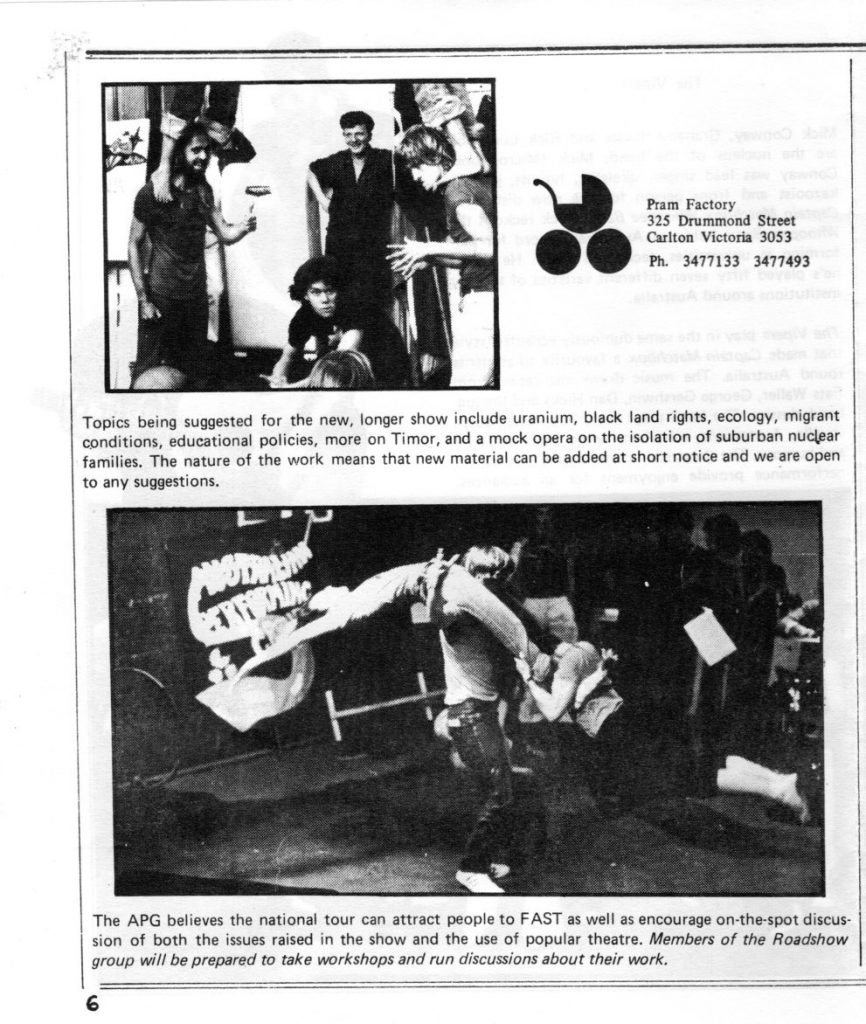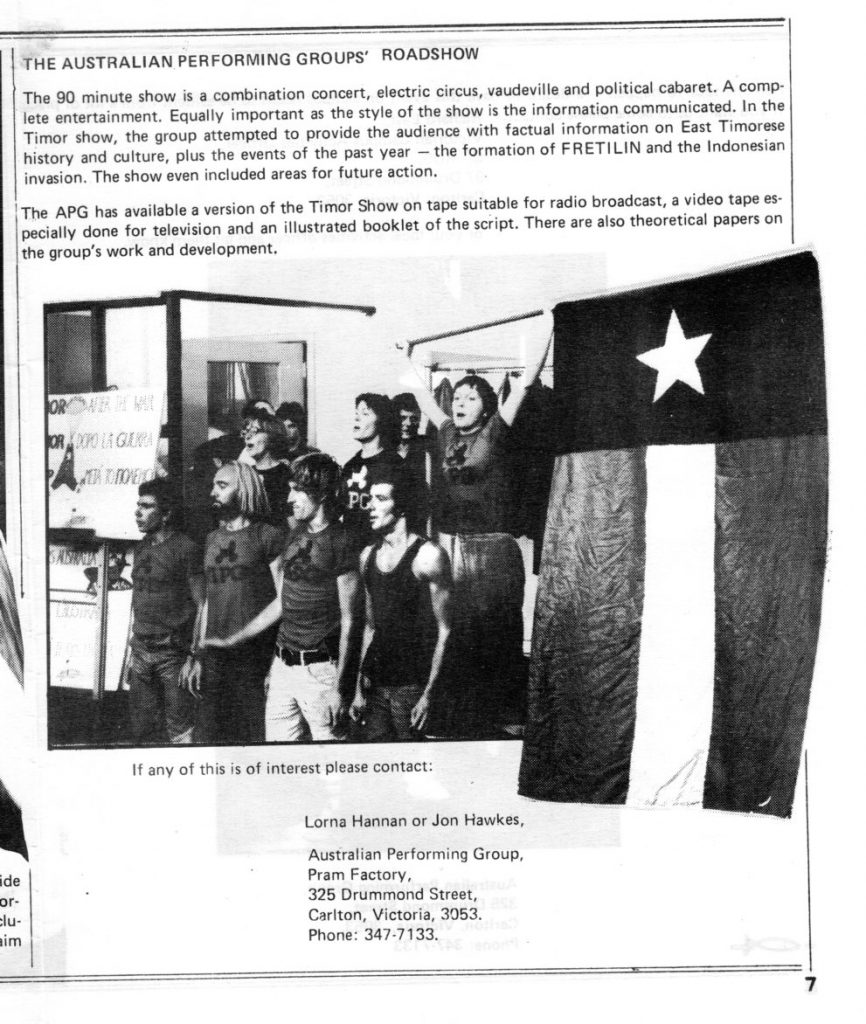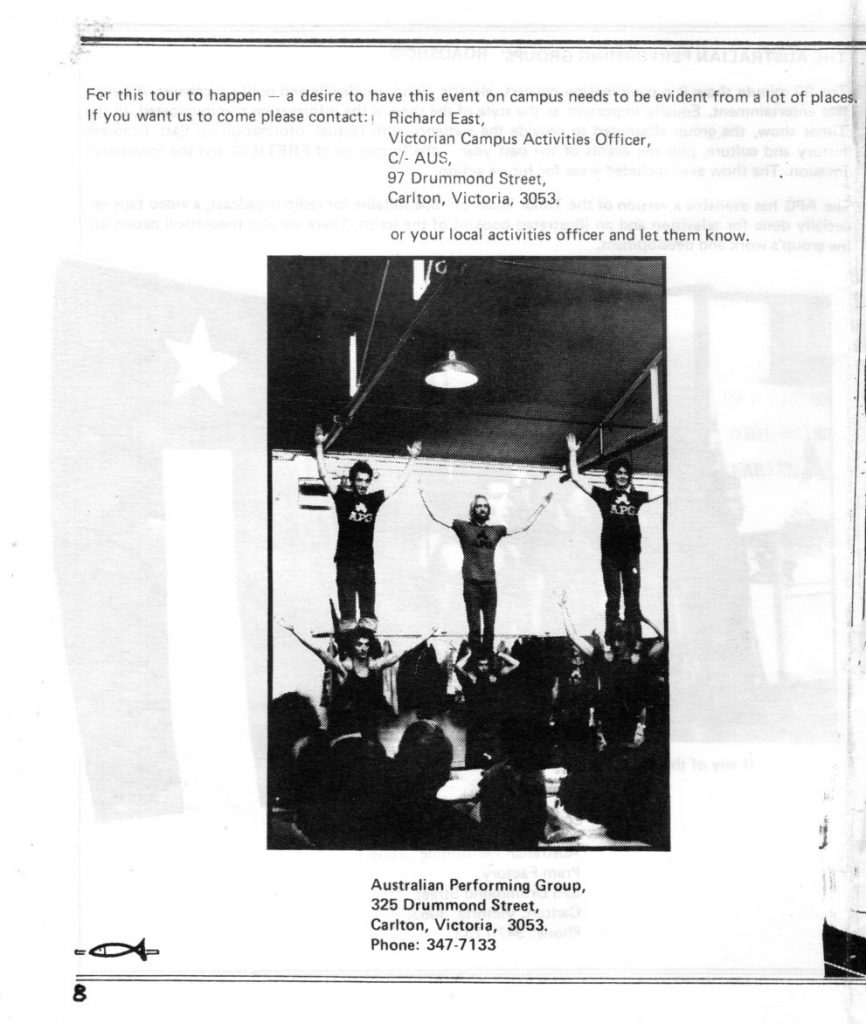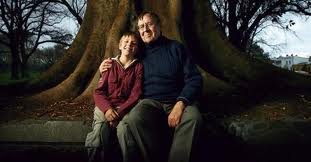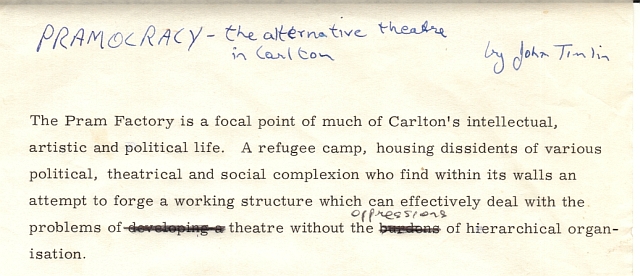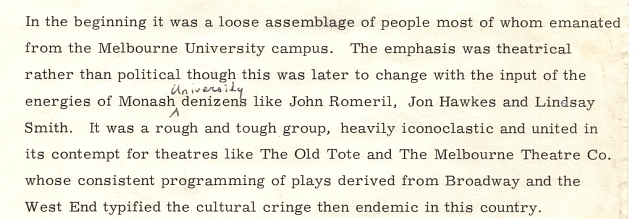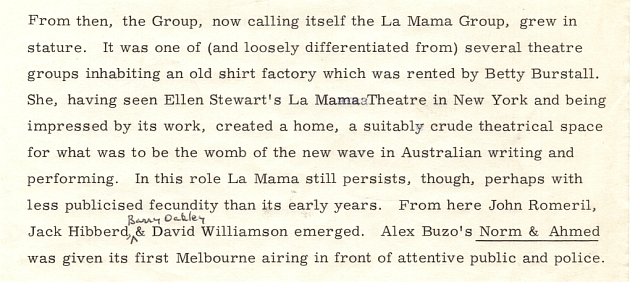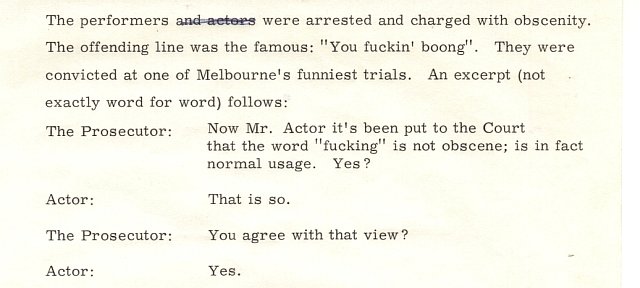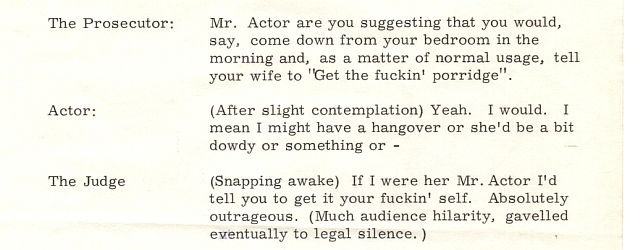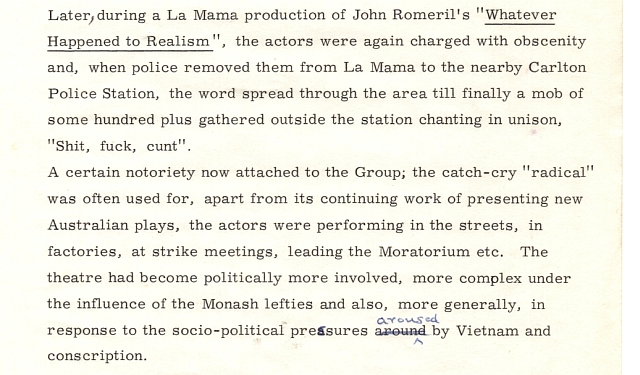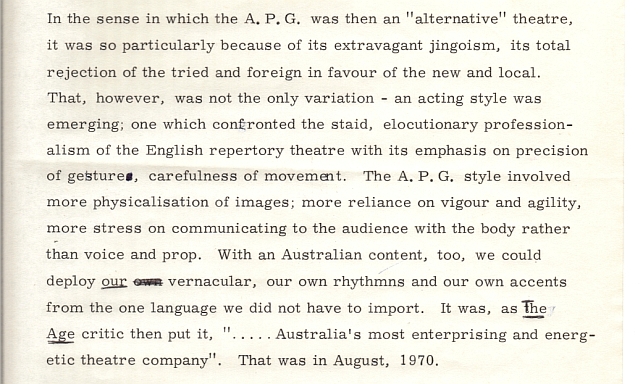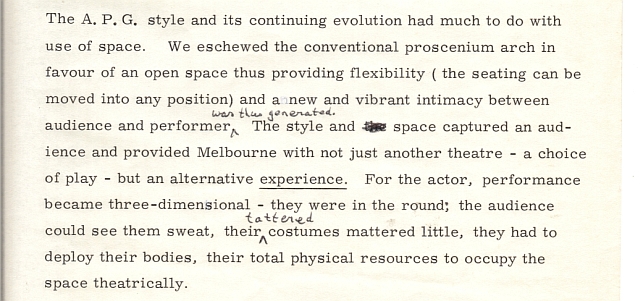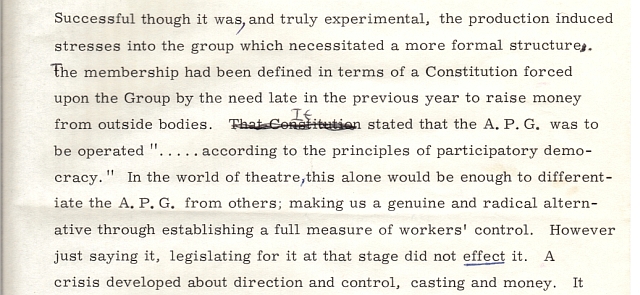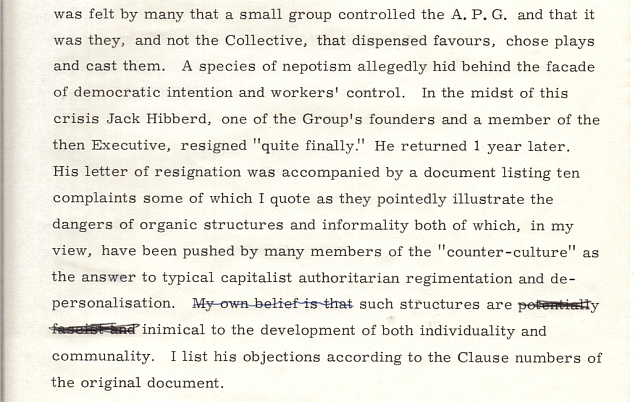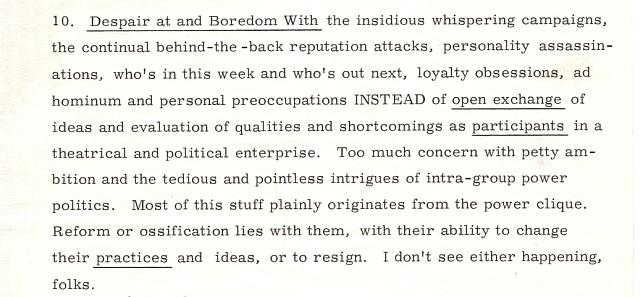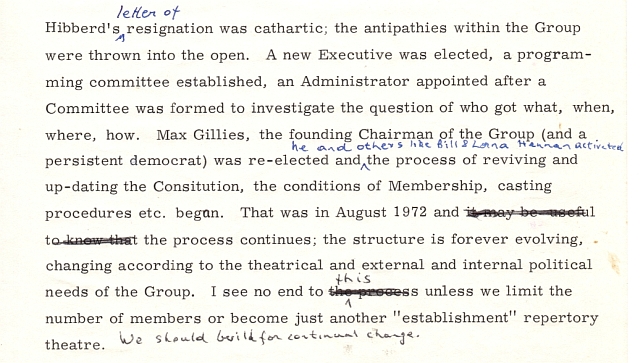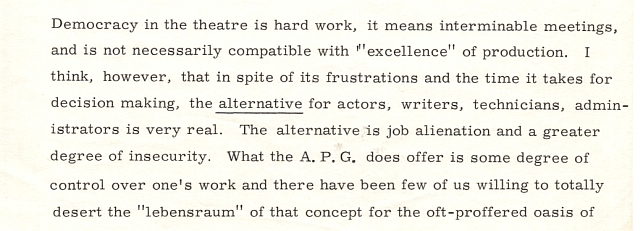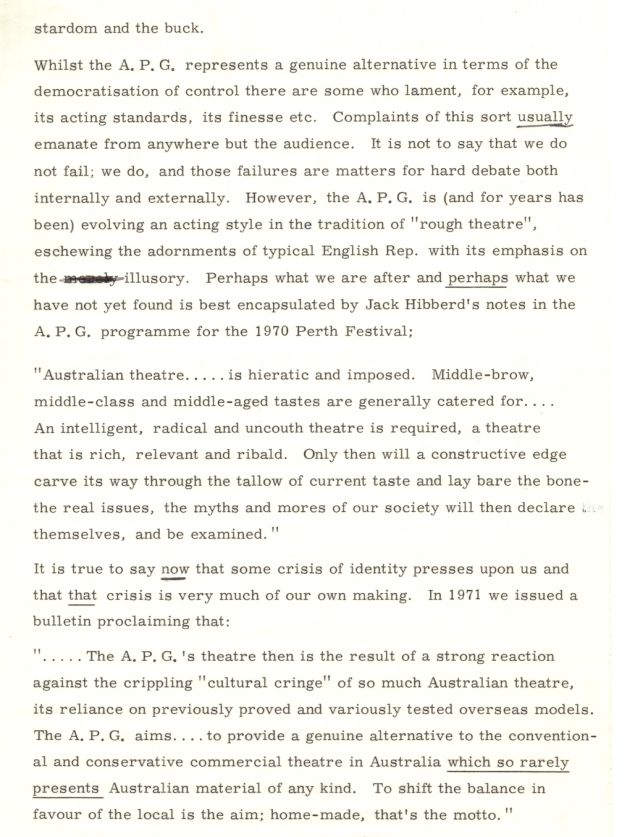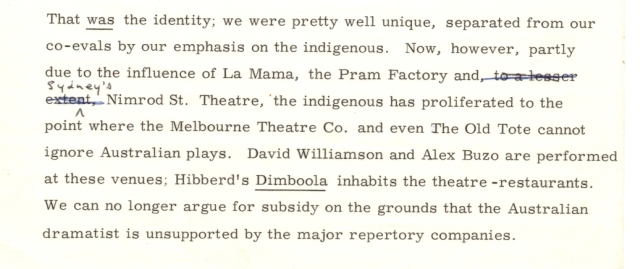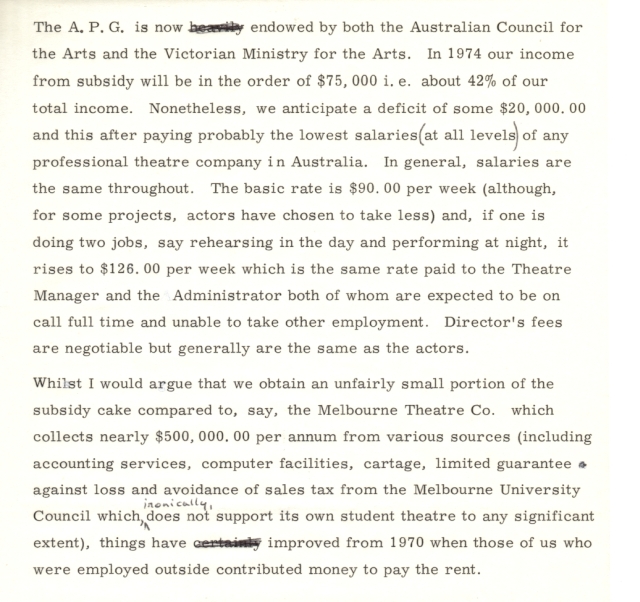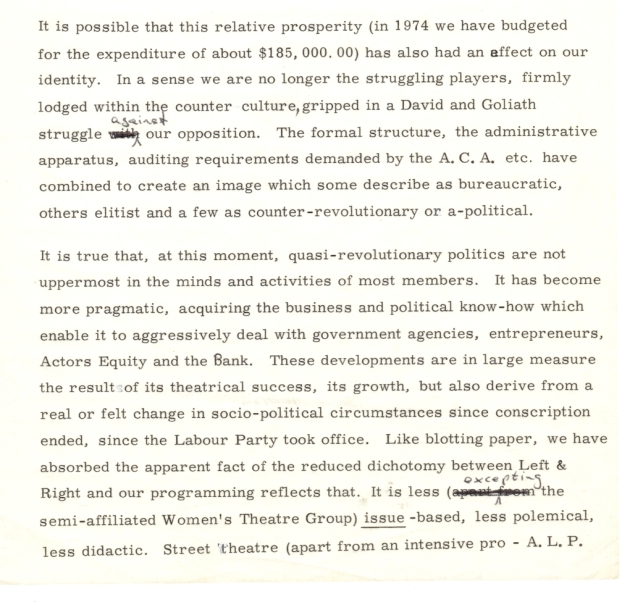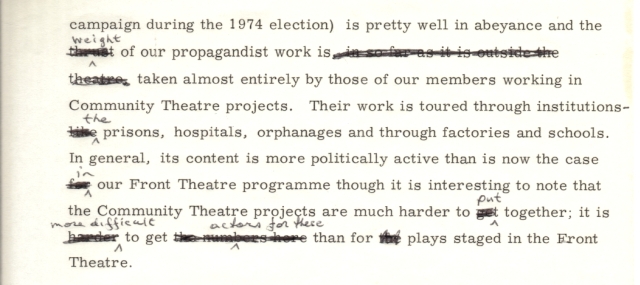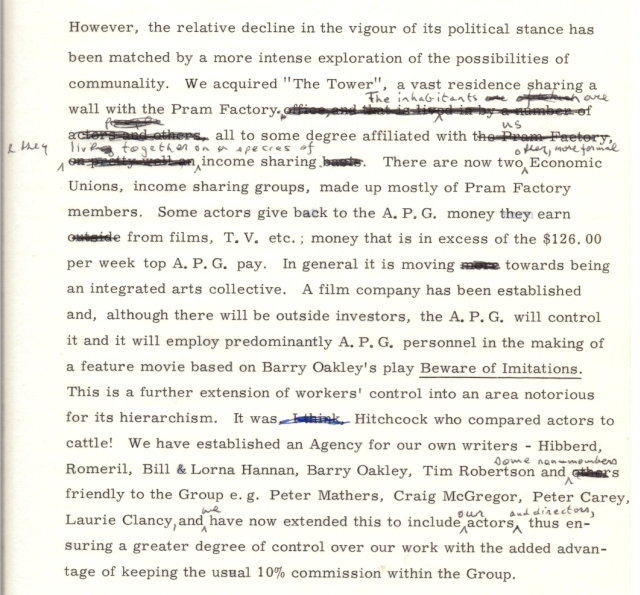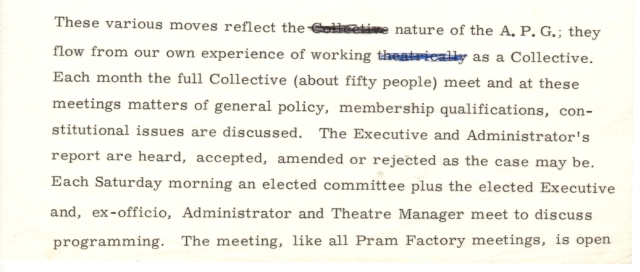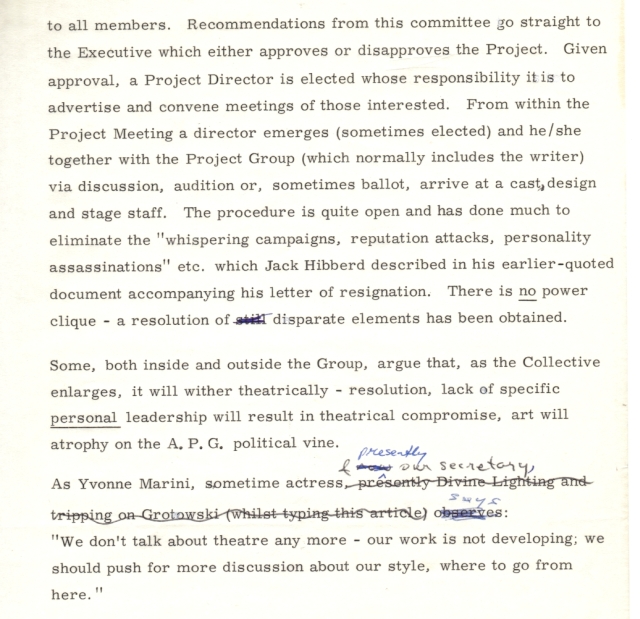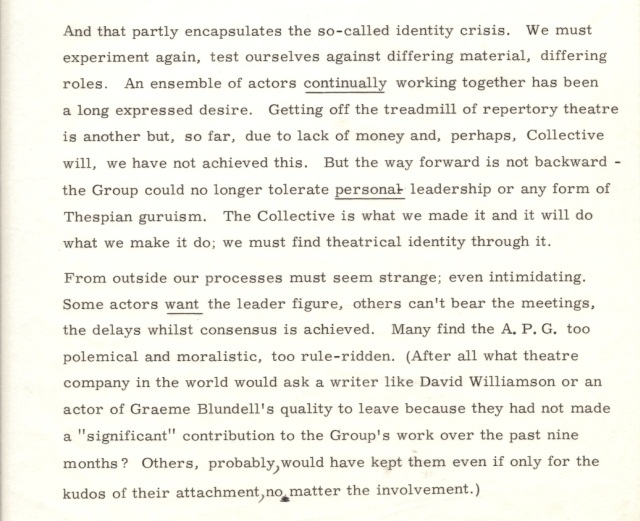Overview
The then unnamed Australian Performing Group (APG) from Melbourne started out in 1967 as a group of writers and actors working together at La Mama theatre in Carlton. In 1970 the APG was officially formed and then set up a theatre in a former pram factory in Drummond Street, Carlton. Here, and in other venues throughout Melbourne and other parts of Australia, the ensemble presented alternative, experimental, avant-garde and radical plays, musical comedies, vaudeville, stage shows, street theatre and circus acts, using comedy, drama, music and dance to entertain and, in some cases, to turn the spotlight on its concerns about social, political and feminist issues. The ensemble also produced a record album (“The Great Stumble Forward: Matchbox and the APG at the Pram”) and a feature length movie (“Dimboola”). Quite a few of the hundred-plus works performed by the APG between 1970 and 1979 received critical and popular acclaim. APG actors, writers and performers had a major impact on the nature and content of live theatre in Australia. Their government-subsidized organisation provided acting, designing, and play-writing opportunities to many people who might not otherwise have had the chance to create.
But by 1981 the group had disintegrated. The only surviving part is “Circus Oz”, an APG off-shoot formed in 1978 when the APG’s Soapbox Circus and The Captain Matchbox Whoopee Band joined with the New Ensemble Circus of Adelaide. It continues to perform in Australia and internationally to this day (July 2013).
Actors, performers, writers, directors and artists
Listed below are writers, actors, directors, artists and others who were part of the APG and/or its Soapbox Circus during its heyday, and whose names may be well known to “mature-age” lovers of Australian alternative theatre, circus, film and television. As others have said, “some (of these people) had a brief connection with the APG; others were there for a long time and were instrumental in its success”.
Blundall, Graeme
Bolza, Joe
Broadway, Sue
Buzo, Alex
Chapman, Eileen
Chong, Rose
Clemson, Helen
Clifton, Jane
Coldwell, Tim
Conway, Mick
Corrigan, Peter
Costelloe, Rose
Cummins, Peter
Daly, Bob
Davies, Lindy
de Winter, Roz
Dickins, Barry
Dobbin, Claire
Dreyfus, George
Duigan, John
Dwyer, Kerry
Finlay, Peter
Frank, Laurel
Friedel, Jan
Friedel, Martin
Garner, Bill
Gedye, Kelvin
Giles, Neil
Gillies, Max
Green, Peter
Hampton, Paul
Hannan, Bill
Hannan, Lorna
Harrison, Ursula
Hawkes, Jon
Hawkes, Ponch
Hibberd, Jack
Ingelton, Sue
Isaac, Graeme
Johnson, Michele
Kemp, Jenny
Kendall, David
Koenig, John
Krape, Evelyn
Last, Wilfred
Laurie, Robin
Ley, John
Long, Ursula
Ludrook, Ric
Maddison, Ruth
Marini, Yvonne
Meldrum, Robert
Meltzer, Larry
Mokotow, Fay
Molan, Phil
Motherwell, Phil
Mullett, Jane
Murphet, Richard
Oakley, Barry
Pickhaver, Greig
Potter, Susy
Porter, Carol
Price, Michael
Richards, Alison
Robertson, Alan
Robertson, Tim
Romeril, John
Shuv’us, James
Sky, Hellen
Smith, Lindzee
Spears, Steve
Spence, Bruce
Taylor, Tony
Thorneycroft, Bob
Underwood, Naomi
Waddell, Gary
Weiner, Jack
Weiss, Bob
Williamson, David
(As I think of/become aware of others I will add them to the list.)
Management
Like most of its productions, management at the APG was also radically different. Instead of a conventional, hierarchical structure, the APG was run as a self-managed collective. Nevertheless, the roles played by John Timlin (publicity and administration) and Jon Hawkes (acting and administration) at times approximated that of manager or overseer. Phil Molan was the sometime lawyer.
Perhaps unsurprisingly, management became somewhat chaotic as the APG grew and conflicts between sub-groups arose. Several influential members departed, some because they became tired of attending the many committee and group meetings held.
Productions
It has been estimated that the APG performed/staged up to 150 theatrical productions. Of those the following are probably the best known from the group’s heyday (alphabetically):
A Stretch of the Imagination
A Toast to Melba
At the Feet of Daniel Mannix
Back to Bourke Street
Bedfellows
Betty Can Jump
Beware of Imitations
Carboni
Chicago Chicago
Chris Langham’s One Man Show
Diary of a Madman
Dimboola
Domestic Contradictions – Socialism in One Room
Don’s Party
Dreamers of the Absolute
Floating World
How Grey Was My Nurse
It’s a Mad World, My Masters
Knuckle
Marvellous Melbourne
Mary Shelley and the Monsters
Mickey’s Moomba
My Foot, My Tutor
On Yer Marx
Pecking Orders
Peggy Sue
Phar Lap – It’s Cingalese for Lightning, Y’know
Radio Active Horror Show
Sisters
Smak’in The Daks
Soabox Circus
Stasis
The Bob and Joe Show
The Dudders
The Floating World
The Golden Holden
The Hills Family Show
The Overcoat
The Ship’s Whistle
Traitors
White With Wire Wheels
Yesterday’s News
Yours for the Masking
History and Opinions in Books, Papers and Online
Thousands of words have been written about the Australian Performing Group and the Pram Factory Theatre. The best that I have read are:
- “Make it Australian: The Australian Performing Group, the Pram Factory and New Wave Theatre”, by Gabrielle Wolf, 2008, Currency Press. To see click HERE.
- The Pram Factory website, developed by Suzanne Ingleton and with the support of
The Myer Foundation: It was at http://www.pramfactory.com/ BUT HAS BEEN MOVED TO https://arts.unimelb.edu.au/research/digital-studio/projects/the-pram-factory
- “When The Way Out Was In: Avant-Garde Theatre in Australia, 1965-1985”, by Adrian John Guthrie, University of Wollongong. A thesis. 1996. See pages 57 onwards. A copy of the thesis, in PDF format, can be downloaded from HERE.
- “The Pram Factory: The Australian Performing Group Recollected”, by Tim Robertson, 1997, Melbourne University Press. Currently (April 2017) the book appears to be unavailable from sellers of new books, but may be available on Ebay or its like.
- See also my page of Links.

END OF THIS POST.

HOME

